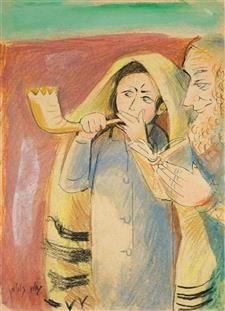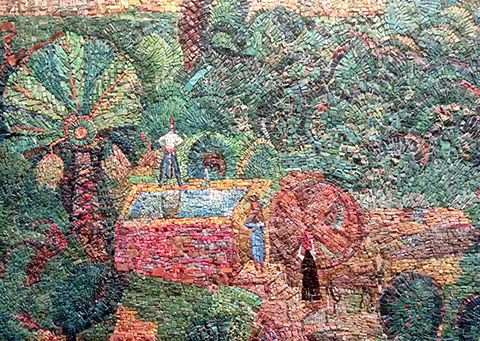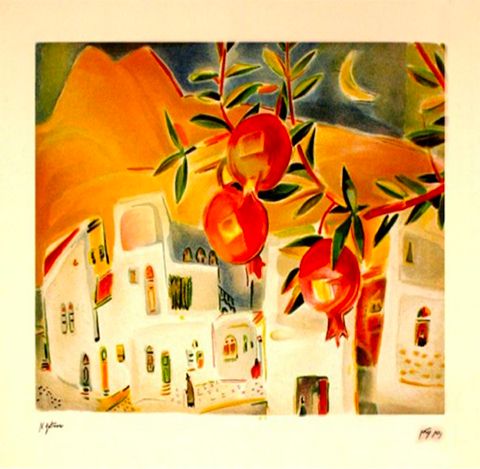Rosh Hashanah
Greetings to all my Jewish family and friends for Rosh Hashanah which starts at nightfall of Monday 6 September and ends nightfall of Wednesday 8 September.
We wish you all a Good and Sweet New Year. May you be blessed with a year full of good fortunes and peaceful harmony of life!
Rosh Hashanah (Hebrew: רֹאשׁ הַשָּׁנָה), literally meaning "head (of) the year", is the Jewish New Year. The biblical name for this holiday is Yom Teruah (יוֹם תְּרוּעָה), literally "day of shouting or blasting", and is also more commonly known in English as the Feast of Trumpets. It is the first of the Jewish High Holy Days (יָמִים נוֹרָאִים Yamim Nora'im. "Days of Awe") specified by Leviticus 23:23–32 that occur in the early autumn of the Northern Hemisphere.1
Rosh Hashanah is a two-day celebration that begins on the first day of Tishrei, which is the seventh month of the ecclesiastical year. In contrast to the ecclesiastical lunar new year on the first day of the first month Nisan, the spring Passover month which marks Israel's exodus from Egypt, Rosh Hashanah marks the beginning of the civil year, according to the teachings of Judaism, and is the traditional anniversary of the creation of Adam and Eve, the first man and woman according to the Hebrew Bible, and the inauguration of humanity's role in God's world.1
Rosh Hashanah customs include sounding the shofar (a cleaned-out ram's horn), as prescribed in the Torah, following the prescription of the Hebrew Bible to "raise a noise" on Yom Teruah. Its rabbinical customs include attending synagogue services and reciting special liturgy about teshuva, as well as enjoying festive meals. Eating symbolic foods is now a tradition, such as apples dipped in honey, hoping to evoke a sweet new year.1
I am going to get Moldovan-born Israeli painter, sculptor, and author Nachum Gutman (1898-1980) to welcome in the Jewish New Year with his gouache and mixed media work on paper as shown below.

Nahum Gutman (1898-1978) was born in Romania and immigrated to Israel in 1905. He grew up in Jaffa, opposite the sand dunes (later to become Tel Aviv), and these locations dominate his landscapes. He was one of the first children to live in the new city of Tel Aviv, and this influential childhood experience is reflected in his books A Small City with Few People and Between Sands and Blue Skies. He became known as prolific children’s book author, and illustrator. His works earned him the title “the artist of early Tel Aviv” seeing as he had a knack for portraying the bohemian and realistic vision of the city and its people.
Gutman is also famous for his illustration of Bialik poems and for mosaics he designed in Tel Aviv: in the Shalom Tower, the Chief Rabbinate Building, and the old City Plaza, Bialik Square. They were created in 1970 and they tell the story of the daily life in Tel Aviv and Jaffa. After his death the Nahum Gutman Museum was founded. It is located in what is considered Tel Aviv’s first Jewish neighborhood, Neve Tzedek. The Mosaic in the western wing of the Shalom Tower tells us of the beginning of the city. The mosaic is divided in four different colors each representing a period in the life of the city. 3
Below is the Nachum Gutman mosaic wall at Shalom Tower, where the old Herzliya Gymnasium once stood; detail showing orchards and a saqiya fountain outside old Jaffa.

Nachum Gutman was only one of the artists who created the mosaic wall inside the Shalom Meyer Tower. Follow this link to the Sweet Tel Aviv blog to read a description of some of the other mosaic works inside Migdal Shalom as it is locally called.
And to conclude today another painting by Nachum Gutman, this one of pomegranates. In the Jewish faith, pomegranates are traditionally eaten on Rosh Hashanah because it has 613 seeds, which coincide with the 613 commandments of the Torah. Furthermore, the pomegranate represents fruitfulness.5

Credits
1. en.wikipedia.org
2. pinterest.ru
3. mosaicartsource.wordpress.com
4. en.wikipedia.org
5. ps.org.au
6. israelforever.org
